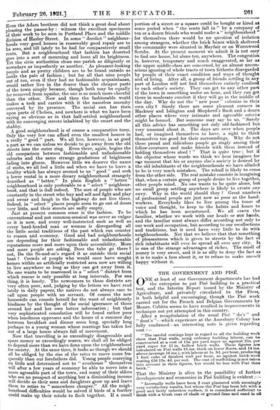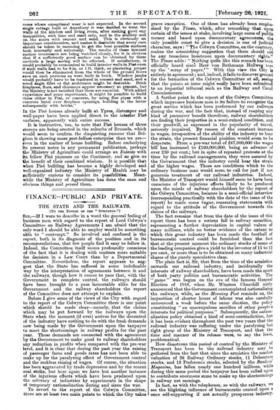THE GOVERNMENT AND PISS.
(INE at least of our Government departments has had _1 the enterprise to put Pise building to a practical test, and the Interim Report issued by the Ministry of Agriculture, and privately circulated to the Press, is both helpful and encouraging, though the Pise work carried out for the French and Belgian Governments by Messrs. Cubitts seems to have resulted in improvements in technique not yet attempted in this country. After a recapitulation of the usual Pise " do's " and " dont's "—which experience at the Amesbury Colony has fully confirmed—an interesting note is given regarding cost :— " The careful coatings kept in regard to all the building work show that Pisa walls, using ordinary building labour, can be constructed at a cost of 15s. per yard super as against 25s: per yard super for 11 in. hollow brick walls. Those figures are calculated on Pis6 walls 18 ins. thick on lower floors, and 14 ins. above (average 16 ins.), with labour at is. 3d. per hour, producing 1 foot cube of finished wall per hour, as against brick-work costing £56 13s. 4d. per rod. The coat of scaffolding is not taken into account in these figures, but would be less with Pis!, than brick."
That the Ministry is alive to the possibility of further developments and economies in Pith building is evident :- "Internally walls have been 2 coat plastered with seemingly very satisfactory results, but whore the Pis6 has been left with a good and fairly unbroken surface, it is considered suflleient to finish with a brush coat of chalk or ground lime and sand in an eases where exceptional wear is not expected. In the second single cottage built at Amesbury it was decided to treat the walls of the kitchen and living room, after making good any inequalities, with lime and sand only, and in the scullery and on the stairs with cement and sand. This is obviously an important consideration, and makes it desirable that every care should be taken in ramming to get the beet possible surfaces both internally and externally. The results of these internal surface treatments are being watched closely, for it is obvious that if. a sufficiently good surface can be obtained by these methods a. large saving will be effected. If satisfactory, it would probably be.economical to build interior walls in Pisa even if such walls bad to be 9 in. or 1 ft. thick, as plastering proper would then be eliminated from the whole of the ground floors save on such portions as were built in brick. Window jambs would probably have to be rendered in cement and sand, and a wood angle fillet or flat architrave might be desirable. Brink fireplaces, flues, and chimneys appear necessary at present, but the Ministry is not satisfied that these are essential. With added experience and some experiment, it might be possible to build these either in Pisa, or concrete, by using flue pipes with a concrete lintel over fireplace openings, building in the latter sebsequently with bricks."
In the Pise houses already built at Ypres, distemper and wall-paper have been applied direct to the inter Pis6 surfaces, apparently with entire success. It is instructive, too, to note that Pith houses of three storeys are being erected in the suburbs of Brussels, which would seem to confirm the disquieting rumour that Bel• glum is showing more post-bellum enterprise than we are.— even in the matter of house building. Before embodying its present notes in any permanent publication, perhaps the Ministry of Agriculture could arrange an Entente with Its fellow Pith pioneers on the Continent, and so give-us the benefit of their combined wisdom. It is possible that when Pith building has become a highly developed and well-organized industry the Ministry of Health may be sufficiently curious to consider its possibilities. Mean- while the Ministry of Agriculture has done the sane and obvious things and proved them.



































 Previous page
Previous page